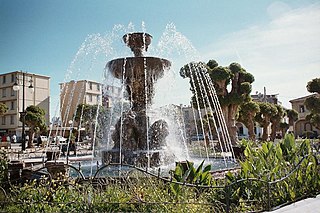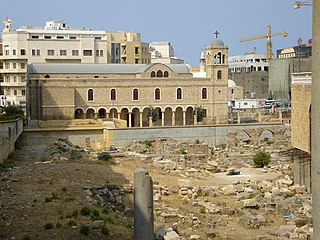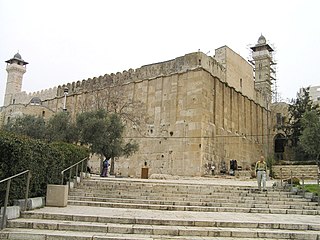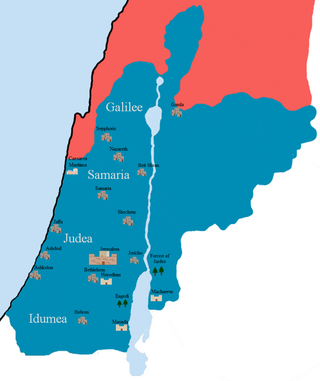Herod I, also known as Herod the Great, was a Roman Jewish client king of Judea, referred to as the Herodian kingdom. He is known for his colossal building projects throughout Judea, including his renovation of the Second Temple in Jerusalem and the expansion of the Temple Mount towards its north, the enclosure around the Cave of the Patriarchs in Hebron, the construction of the port at Caesarea Maritima, the fortress at Masada, and Herodium. Vital details of his life are recorded in the works of the 1st century CE Roman–Jewish historian Josephus.

Herod Agrippa, also known as Herod II or Agrippa I, was a grandson of Herod the Great and last Jewish King of Judea from AD 41 to 44. He was the father of Herod Agrippa II, the last king from the Herodian dynasty. He spent his childhood and youth at the imperial court in Ancient Rome where he befriended the imperial princes Claudius and Drusus, the son of Tiberius. He suffered a period of disgrace following the death of Drusus which forced him to return to live in Judea. Back in Rome around 35, Tiberius made him the guardian of his grandson Tiberius Gemellus and Agrippa approached the other designated heir, Caligula. The advent of the latter to the throne allowed him to become king of Batanea, Trachonitis, Gaulanitis, Auranitis, Paneas and Chalcis in 37 by obtaining the old tetrarchies of Philip and Lysanias, then Galilee and Perea in 40, following the disgrace of his uncle, Herod Antipas.

Caesarea or Caesarea Maritima was an ancient and medieval city in the Sharon plain on the coast of the Eastern Mediterranean, and later a small fishing village. Today located in Caesarea, Israel, it has also been called Caesarea Palestinae, mostly before the establishment of the State of Israel in 1948. Today, the site is an Israeli national park and its ruins are part of the Caesarea National Park.
An obelisk is a tall, four-sided, narrow tapering monument which ends in a pyramid-like shape or pyramidion at the top. Originally constructed by Ancient Egyptians and called tekhenu, the Greeks used the Greek term obeliskos to describe them, and this word passed into Latin and ultimately English. Though William Thomas used the term correctly in his Historie of Italie of 1549, by the late sixteenth century, Shakespeare failed to distinguish between pyramids and obelisks in his plays and sonnets. Ancient obelisks are monolithic; they consist of a single stone. Most modern obelisks are made of several stones.

Sultanahmet Square or the Hippodrome of Constantinople is a square in Istanbul, Turkey. Previously, it was a circus that was the sporting and social centre of Constantinople, capital of the Byzantine Empire.

Judaea was a Roman province which incorporated the regions of Judea, Samaria, and Idumea from 6 CE, extending over parts of the former regions of the Hasmonean and Herodian kingdoms of Judea. The name Judaea, like the similar Judea, was derived from the Iron Age Kingdom of Judah, but the Roman province encompassed a much larger territory.

Cherchell is a town on Algeria's Mediterranean coast, 89 kilometers (55 mi) west of Algiers. It is the seat of Cherchell District in Tipaza Province. Under the names Iol and Caesarea, it was formerly a Roman colony and the capital of the kingdoms of Numidia and Mauretania.

A Roman circus was a large open-air venue normally used for chariot races and horse races, although sometimes served other purposes. It was similar to the ancient Greek hippodrome. Along with theatres and amphitheatres, circuses were one of the main entertainment venues the time.

Berytus, briefly known as Laodicea in Phoenicia or Laodicea in Canaan from the 2nd century to 64 BCE, was the ancient city of Beirut from the Roman Republic through the Roman Empire and Early Byzantine period/late antiquity. Berytus became a Roman colonia that would be the center of Roman presence in the eastern Mediterranean shores south of Anatolia. The veterans of two Roman legions under Augustus were established in the city, that afterward quickly became Romanized and was the only fully Latin-speaking city in the Syria-Phoenicia region until the fourth century. Although Berytus was still an important city after earthquakes, around 400 CE Tyre was made the capital of the Roman province of Phoenicia. "Of the great law schools of Rome, Constantinople, and Berytus", the law school of Berytus stood "pre-eminent". The Code of Justinian was mostly created in this school.

The Walled Obelisk or Masonry Obelisk is a Roman monument in the form of an obelisk in the former Hippodrome of Constantinople, now Sultanahmet Square in Istanbul, Turkey. It is situated west of the Sultan Ahmed Mosque, at the southern end of the ancient chariot-racing track of Constantinople's central barrier, beside the Obelisk of Theodosius and the Serpentine Column. Its original construction date in late antiquity is unknown, but it is sometimes named Constantine's Obelisk after the inscription added by the Roman emperor Constantine VII Porphyrogenitus, who repaired it in the 10th century.

The Pilate stone is a damaged block of carved limestone with a partially intact inscription attributed to, and mentioning, Pontius Pilate, a prefect of the Roman province of Judea from AD 26 to 36. It was discovered at the archaeological site of Caesarea Maritima in 1961. The artifact is particularly significant because it is an archaeological find of an authentic 1st-century Roman inscription mentioning the name "[Pont]ius Pilatus". It is contemporary to Pilate's lifetime, and accords with what is known of his reported career. In effect, the inscription constitutes the earliest surviving, and only contemporary, record of Pilate, who is otherwise known from the New Testament and apocryphal texts, the Jewish historian Josephus and writer Philo, and brief references by Roman historians such as Tacitus.

The Lateran Obelisk is the largest standing ancient Egyptian obelisk in the world, and it is also the tallest obelisk in Italy. It originally weighed 413 tonnes, but after collapsing and being re-erected 4 metres (13 ft) shorter, now weighs around 300 tonnes. It is located in Rome, in the square across from the Archbasilica of St. John Lateran and the San Giovanni Addolorata Hospital.

Philip the Tetrarch, sometimes called Herod Philip II by modern writers, son of Herod the Great and his fifth wife, Cleopatra of Jerusalem, ruled over the northeast part of his father's kingdom between 4 BCE and 34 CE. He was a half-brother of Herod Antipas and Herod Archelaus and should not be confused with Herod II, whom some writers call Herod Philip I.

The Obelisk of Theodosius is the Ancient Egyptian obelisk of Pharaoh Thutmose III re-erected in the Hippodrome of Constantinople by the Roman emperor Theodosius I in the 4th century AD.

Herodian architecture is a style of classical architecture characteristic of the numerous building projects undertaken during the reign of Herod the Great, the Roman client king of Judea. Herod undertook many colossal building projects, most famously his reconstruction of the Temple in Jerusalem. Many of his structures were built upon comparable, previous Hasmonean buildings and most of his have, in their turn, vanished as well.

Palazzo degli Elefanti is a historical building in Catania, region of Sicily, southern Italy. It currently houses the city's Town Hall. In the past, the prior building was also known as the Palazzo Senatorio or Loggia Senatoria.

The Herodian Kingdom of Judea was a client state of the Roman Republic from 37 BCE, when Herod the Great, who had been appointed "King of the Jews" by the Roman Senate in 40/39 BCE, took actual control over the country. When Herod died in 4 BCE, the kingdom was divided among his sons into the Herodian Tetrarchy.
An earthquake occurred in Antioch on 13 December 115 AD. It had an estimated magnitude of 7.5 on the surface wave magnitude scale and an estimated maximum intensity of XI (Extreme) on the Mercalli intensity scale. Antioch and surrounding areas were devastated with a great loss of life and property. It triggered a local tsunami that badly damaged the harbour at Caesarea Maritima. The Roman Emperor Trajan was caught in the earthquake, as was his successor Hadrian. Although the consul Marcus Pedo Vergilianus was killed, they escaped with only slight injuries and later began a program to rebuild the city.
The hippodrome of Berytus was a circus in the Roman colony of Berytus. It is one of two hippodromes in Beirut.















